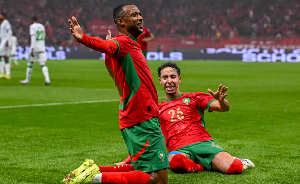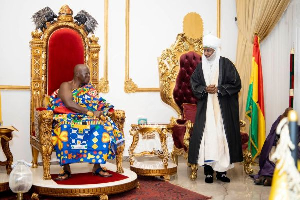In the first part of this article with the above caption and the subtitle “Where Is the Union Agreement Between Ghana and Western Togoland?” the PLC sought to clarify some of the dynamics pertaining to the Ghana-Western Togoland issue and referred to some portions of a document laid before the British Parliament (House of Commons) by the Administering Authority (British Government) of Togoland under British Administration for the perusal of our cherished readers.
We wish to reiterate those points by referencing those documents again as follows and to complete our series on the topic “What Is the Future of Western Togoland.”
Our constant call on the current government of the Republic of Ghana to take the needed legal and constitutional steps to regularise the Union between Ghana and Western Togoland as contained in the United Nations (UN) Resolution 1044(XI) of December 13 1956, passed at its General Assembly sitting, prior to the infamous 1956 Plebiscite which has become the basis of all the back and forth between Ghana and Western Togoland and it’s people all these decades is born out of the conviction that the manifest aspirations of the people of the then Togoland under British administration(Western Togoland), which was an overwhelming vote in favour of a Union between an independent Gold Coast (Ghana) and Western Togoland had for several decades been undermined by successive Governments of the Republic of Ghana, hence leaving the people of the then British administered territory in the margins.
This resolution stated in part that the UN,
“Expresses its approval of the Union of the Territory of Togoland under British administration with an independent Gold Coast and accordingly invites the administering authority to take such steps as are necessary to this end.”
“Resolves with the agreement of the administering authority that on the date the Gold Coast becomes independent and the Union with it of the Territory of Togoland under British administration takes place, the Trusteeship Agreement approved by the General Assembly in Resolution 63 (1) of 13 December 1946 shall cease to be in force, the objectives of Trusteeship having been attained.”
“Requests the government of the United Kingdom of Great Britain and Northern Ireland to notify the Secretary-General as soon as the Union of the Territory of Togoland under British administration and an independent Gold Coast have been effected.”
“Requests the Secretary-General to communicate to all Member States and the Trusteeship Council at its Nineteenth Session the notification by the government of the United Kingdom of Great Britain and Northern Ireland.”
Judging from the above, one would agree with the PLC that the future of the British-administered territory of Western Togoland was to be determined based on the agreement that a legal union be instituted between an independent Gold Coast (Ghana) and the Trust Territory of Togoland, taking into consideration the manifest aspirations of the territory under British administration.
This presupposes that Western Togoland would not and should not be annexed by an independent Gold Coast, as has been the case since the Gold Coast got its independence from Great Britain, but rather a separate state on its own joined in union with Ghana, a typical example being that of Zanzibar and Tanganyika (now Tanzania).
Instead, the reverse had been the case, with Ghana’s first President, Dr. Kwame Nkrumah, and his collaborators willfully and clandestinely thwarting the decision and desires of the people of Western Togoland and forcefully annexing the territory into Ghana without any negotiations or consultation with its leaders, making the whole game look like a recolonization of the territory by Ghana.
Suffice us to say that this diabolical move by Kwame Nkrumah and his cohorts, which is a clear violation of the aspirations of the people of Western Togoland, is the reason many people have been calling for a secession of the territory from Ghana.
The PLC has been referring to these portions of the resolution above to reestablish the fact that, from the very onset, the government of Great Britain and the UN have already agreed and mapped out a strategy for the Union between an independent Gold Coast and Western Togo that was to be adhered to by all parties involved in the process.
But the fact still remains that all these protocols and agreements were not followed by the Administering Authority, Great Britain, and the Gold Coast, leading to the current state of affairs—the Ghana-Western Togoland Conundrum.
It is, however, important to note that, while the PLC has over the past years been calling for the regularization of the union between Ghana and Western Togoland, other schools of thought have misconstrued that as a call for the secession of Western Togoland from Ghana.
Many people, including the Government of Ghana, have argued that the so-called union being trumpeted by the PLC has, since the dawn of the Gold Coast’s independence, been affected.
However, the question that remains unanswered is whether there is a Union Agreement signed between Ghana and Western Togo to warrant these claims.
Indeed, as pointed out in the first part of this article, the Queen of England was aware that the people of Western Togoland had never been colonized by Britain and that her government did not have and could not lay any claims to the territory under her government’s administration. How can a territory that has never experienced colonization be said to be independent? Western Togoland had been an independent territory long before the Gold Coast got its independence from British rule. In fact, there are numerous documents in the possession of the PLC from the British Parliament and the UN archives to this effect.
We wish to refer once again to a Hansard from the British Parliament dated December 1956, available to the PLC, that sought to throw more light on the whole Western Togo-Ghana Conundrum before the then-Gold Coast got its independence from Great Britain, which stated as follows:
“Her Majesty’s Government do not consider that the partitioning of the Gold Coast is in the interest of the Gold Coast as a whole or of any of its parts and cannot abandon their established policy, which is destined to grant of independence to the Gold Coast as a whole – (Hansard, British Parliament, December 11, 1956)
It is not far-fetched that the agreement reached by the UN and the administering authority of Togoland under British administration was for Western Togoland to be joined in a union with an independent Gold Coast. This agreement came about as a result of the overwhelming vote in favour of the Union after the Plebiscite. But as to whether the tenets of this agreement have been adhered to by all the parties and the Union effected to date, there is a lot to be desired.
It should be pointed out here that no amount of intimidation and suppression of the rights and liberties of the people of Western Togo by the government of Ghana can ever prevent the people from fighting for the right thing to be done, which is for the government of Ghana to take immediate steps to regularise the Union agreed upon before the dawn of Ghana’s independence.
The earlier this union is affected, the better it will be for both Ghana and Western Togo. This, we believe, would also further consolidate the peace and security of Ghana and the territory of Western Togoland going forward.
Opinions of Monday, 6 May 2024
Columnist: Peoples Liberation Council















